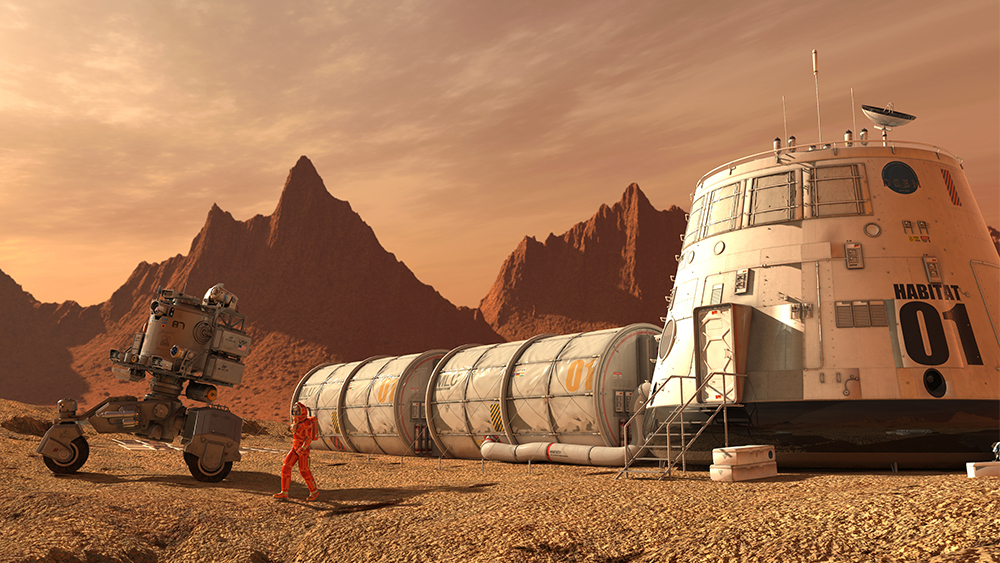
A new Texas A&M University-developed technique that allows for the creation of building materials using local soils could prove key not only to the success of future space missions to the moon and Mars but also to establishing a solid and safe foothold on both — a futuristic concept that came one step closer to reality with last week’s successful landing of NASA’s Perseverance rover on the surface of Mars.
Thanks to a 2021 NASA Innovative Advanced Concepts (NIAC) Program grant awarded to a team led by Texas A&M researcher and NASA NIAC Fellow Dr. Sarbajit Banerjee, an innovation that began with boggy, water-logged soils from Canada to Texas may soon be applied to the rocky, razor-sharp regolith that dominates the lunar and Martian landscapes in order to help solve a three-part problem Banerjee says has plagued the space agency since the Apollo missions: excessive dust, unnecessary damage and untold danger.
“Five of the six Apollo landings had issues with dust blocking the astronauts’ view of the surface, forcing them to guess at the final landing location and sometimes landing on slopes dangerously close to the maximum tolerance — one time, precariously close to a major crater,” said Banerjee, a professor in the Department of Chemistry with an affiliated appointment in the Department of Materials Science and Engineering. “If NASA and its commercial partners are to mount a sustained presence on the Moon and Mars and land on outer solar system bodies, we need to find a way to tame surface materials for landing and mobility.”
Banerjee, in collaboration with colleagues in the Texas A&M College of Engineering and College of Architecture, proposes to do just that in his team’s NIAC effort, “Regolith Adaptive Modification System (RAMS) to Support Early Extraterrestrial Planetary Landings and Operations.” Their publication is one of 16 selected by NASA for Phase I awards out of nearly 300 proposals submitted for consideration. Each award provides nine months of seed funding that allows researchers to further develop their ideas in order to compete for up to $500,000 more in Phase II funding that will help them further advance and refine their technology over the course of two additional years.
For more than two decades, the NIAC Program has nurtured visionary ideas capable of transforming future NASA missions with the creation of breakthroughs — radically better or entirely new aerospace concepts — while engaging America’s innovators and entrepreneurs as partners in the journey. The program seeks innovations from diverse and non-traditional sources, selecting projects that study innovative, technically credible, advanced concepts that could one day “change the possible” in aerospace.
In much the same way they previously created an economical, environmentally friendly alternative to concrete using clay-based soil from a backyard in Texas or a geopolymerized wood fiber prototype suitable for all weather-roads using mucky Canadian muskeg soil, Banerjee and his team are confident their NIAC team can create landing pads and other prepared surfaces on Mars out of regolith to address what he sees as one of the most critical surface-related developments since the Apollo program.
The Texas A&M team’s proposed RAMS approach relies on sequentially delivered microcapsules chemically tuned to react with the components of regolith through a series of exothermic reactions to create geopolymerized subsurface slabs. By employing a similar process that helped them perfect the development of sustainable building materials which quickly gain strength after being 3D printed, the team will use a sequence of chemical reactions to coat all surfaces and make high-strength vanadium steel skins and anchors using a de facto nano steel mill powered by locally harvested minerals and highly exothermic reactions. As an added bonus, Banerjee notes the nanothermite and encapsulating systems necessary to run it are both lightweight and safe to fly.
The team is a subset of the Texas A&M Lunar Surface Experiments Program, comprised of both faculty and student researchers whose purpose is to design and build fundamental science experiments and technology demonstrations to be delivered to the lunar surface as payloads aboard commercial lunar landers, thereby making the moon a new laboratory for Texas A&M.
View a complete list of NIAC awards for 2021 and previous years.
This article originally appeared on the Texas A&M College of Science website.